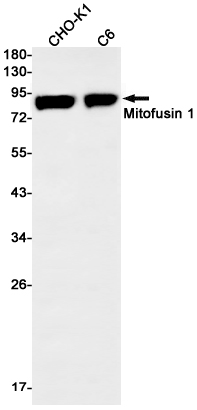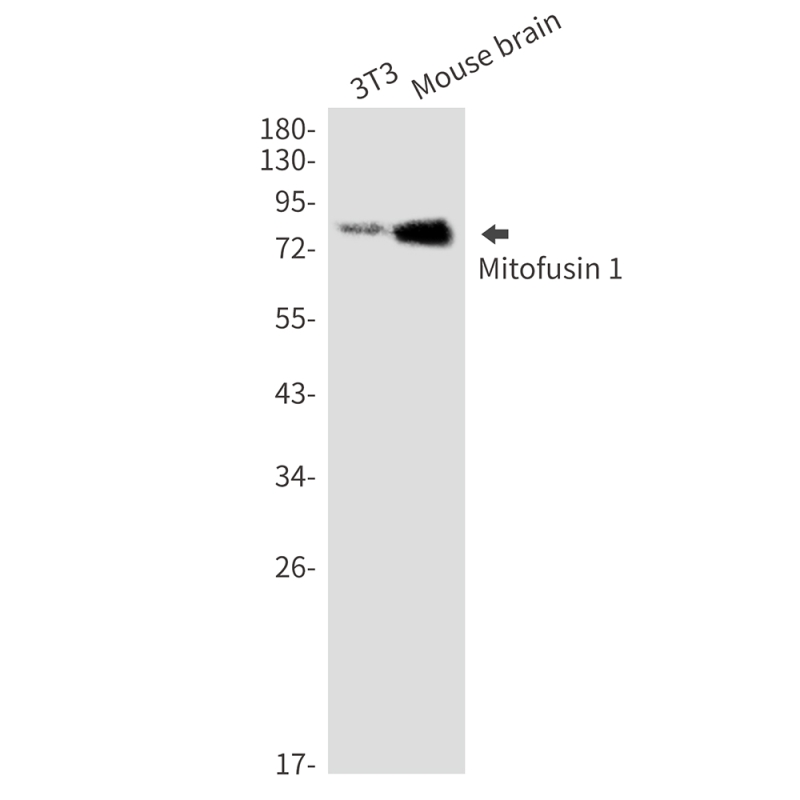

| WB | 咨询技术 | Human,Mouse,Rat |
| IF | 咨询技术 | Human,Mouse,Rat |
| IHC | 咨询技术 | Human,Mouse,Rat |
| ICC | 技术咨询 | Human,Mouse,Rat |
| FCM | 1/200 - 1/400 | Human,Mouse,Rat |
| Elisa | 1/10000 | Human,Mouse,Rat |
| Aliases | HR2; mKIAA4032; D3Ertd265e; 2310002F04Rik; 6330416C07Rik |
| Entrez GeneID | 192647 |
| WB Predicted band size | Calculated MW: 84 kDa; Observed MW: 84 kDa |
| Host/Isotype | Rabbit IgG |
| Antibody Type | Primary antibody |
| Storage | Store at 4°C short term. Aliquot and store at -20°C long term. Avoid freeze/thaw cycles. |
| Species Reactivity | Mouse,Rat,Hamster |
| Immunogen | A synthetic peptide of rat Mitofusin 1 |
| Formulation | Purified antibody in TBS with 0.05% sodium azide,0.05%BSA and 50% glycerol. |
+ +
以下是3篇涉及PELP1抗体的研究文献及其摘要(基于公开研究总结,非实时检索结果):
---
1. **文献名称**: *"PELP1 is a novel mediator of estrogen receptor signaling in breast cancer"*
**作者**: Vadlamudi RK et al.
**摘要**: 该研究首次报道PELP1作为雌激素受体(ER)的共激活因子,通过其抗体进行免疫沉淀和Western blot分析,揭示了PELP1与ER的相互作用促进乳腺癌细胞增殖,并参与激素非依赖性信号通路的激活。
2. **文献名称**: *"PELP1 promotes oncogenic progression through Src kinase activation in breast cancer"*
**作者**: Rajhans R et al.
**摘要**: 研究发现PELP1通过激活c-Src信号通路促进乳腺癌细胞侵袭和迁移,利用PELP1特异性抗体进行免疫荧光和共定位分析,证实其在细胞质与细胞核中的双重分布对肿瘤进展至关重要。
3. **文献名称**: *"Therapeutic targeting of PELP1 in endocrine-resistant breast cancer"*
**作者**: Chakravarty D et al.
**摘要**: 该研究通过免疫组化(使用PELP1抗体)分析临床样本,发现PELP1高表达与乳腺癌内分泌治疗耐药性相关,并验证了靶向抑制PELP1可恢复肿瘤细胞对激素治疗的敏感性。
---
**备注**:以上文献信息为示例,实际引用时需通过PubMed或学术数据库核实具体标题、作者及摘要内容。建议使用关键词“PELP1 antibody”或“PELP1 immunohistochemistry”检索最新研究。
**Background of PELP1 Antibody**
PELP1 (Proline-, Glutamic acid-, and Leucine-rich Protein 1), also known as PHF20. is a scaffolding protein involved in transcriptional regulation, signal transduction, and epigenetic modifications. It interacts with nuclear receptors (e.g., estrogen receptor, ER) and chromatin-modifying complexes, acting as a coactivator to regulate hormone-responsive gene expression. PELP1 is critical in cell proliferation, survival, and differentiation, with dysregulation linked to cancers, particularly hormone-dependent malignancies like breast and ovarian cancer. Overexpression of PELP1 correlates with tumor progression, therapy resistance, and metastasis, often via aberrant activation of oncogenic pathways (e.g., PI3K/AKT, MAPK).
PELP1 antibodies are essential tools for detecting PELP1 expression and localization in research. They enable the study of its role in cancer biology, hormone signaling, and epigenetic regulation through techniques like Western blotting, immunohistochemistry, and co-immunoprecipitation. These antibodies help identify PELP1’s interactions with partners (e.g., histone modifiers, kinases) and its post-translational modifications, which influence its oncogenic functions. Developing specific PELP1 antibodies has advanced therapeutic targeting strategies, as inhibiting PELP1-associated pathways may offer potential in treating cancers with PELP1 dysregulation.
×